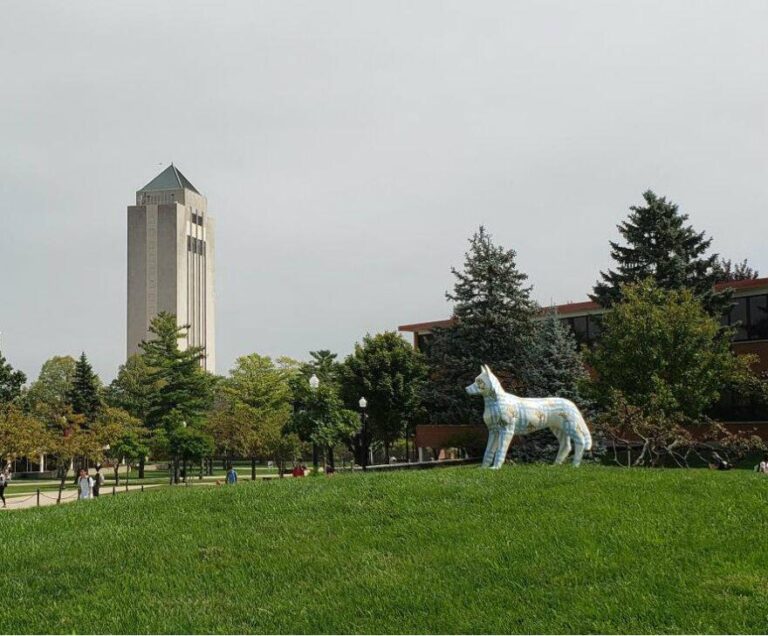DEKALB — Illinois Governor J.B. Pritzker just signed a nearly $47 billion budget into law. That includes substantial increases to the need-based student Monetary Award Program — or MAP Grants. WNIJ’s Peter Medlin talked with Partnership for College Completion policy manager Mike Abrahamson about what it means for Illinois college students.
Peter Medlin, WNIJ education reporter (PM): What were some of your biggest takeaways for what this budget means for higher education and specifically for students in Illinois?
Mike Abrahamson, policy manager at the Partnership for College Completion (MA): Yeah, I think for students, and the bottom line for higher education in this budget is a very positive one. It sends a message to the state that we’re supporting students from low-income backgrounds and being able to access, persist and complete college. More specifically, I think the $122 million increase for MAP is going to serve tens of thousands of additional students and it’s going to start us down this path to increasing award amounts as well.
PM: So, not just more students getting MAP grants, but people getting more money through those grants.
MA: They can now award up to 50% of public university tuition, which is a significant increase from, I believe, 38%.
PM: I mean, just how substantial is this, especially compared to the budgets we’ve had over the past couple of years?
MA: Extremely impactful. It aligns with the promise we had toward $600 million in MAP at this point, it catches up to that. So now, I believe it’s $601 million dollars for MAP and it will have a significant impact on students being able to afford college. But also, beyond that, I think it also sends a message to students. The unsure nature of funding over the last 10 years at least has really hurt us in Illinois and it contributes to the declining enrollments that we’ve seen. We have tens of thousands of fewer students than we had in Illinois 10 years ago.
PM: Okay, so we mentioned the increase in MAP grants. I want to touch on a couple of the other big points from that [budget]. There’s the 5% increase to universities and community colleges’ operations budget, right?
MA: Yes. And that too, I would say is a step forward. Right now we’re figuring out how, as a state, we can have a system that more adequately, equitably, and stably funds our universities, and this continues to support our colleges and universities as we figure out that system.
PM: I’m glad you brought that up. We’re going to put a bookmark there because I want to save that point for later. So, we have that 5% increase. There are also increases in things like adult education, career and technical, and scholarships for minority teachers. Are there any other big ones you want to make sure that we focus on a little bit that you think is really important?
MA: I think the Minority Teachers for Illinois scholarship, that $2.3 million increase is definitely important to note.
PM: Okay. Let’s get to what we’ve been hinting at before. In 2020, the Partnership for College Completion released a report saying that Illinois needs to change the way that it funds higher ed. And now it looks like Illinois is on the path to potentially doing that. There’s a committee investigating how to do it properly. Can you talk to us about why that’s important, and what that means to change the way that universities are funded?
MA: Basically, in Illinois, right now we’re one of the few states that for the vast majority, I think 99.5%, of our funding is given out based heavily on how we gave it out last year, not necessarily on a system that considers what students adequately need to succeed. How can we turn the system from being one of the few in the country that really doesn’t have much of a system behind it to potentially leading the country in terms of equity?
PM: Is there anything about this conversation we’re having about the budget and the impact it has on students that you think is more important than people might realize if they’re just skimming a headline?
MA: I think that costs in higher education are a difficult problem to grapple with. Because students pay for part of it, the state pays for part of it and federal funds are in play as well. That difficulty has, I think, made funding more scarce in a lot of states and I think especially in Illinois over the last 20 years. But I think the evidence all points to reinvesting in higher education as having unique [benefits]. It’s hard to overstate the opportunities it will give the state if we reinvest in higher education equitably in a targeted way. I think in this budget, we’re starting to see that reinvestment.
It’s really exciting to see, but we need to keep our foot on the gas pedal to make sure that we’re continuing to invest in our colleges, universities, and our students. We’ve seen unique disinvestment in our colleges and universities over the last 20 years. And now we’re seeing this reinvestment and [again] I think it’s exciting to see.
PM: But the headline is ‘don’t stop now?’
MA: Exactly. Yeah. Because we have to continue to lower costs for students and adequately fund universities so that they can serve students. So yes, don’t stop now. I think that is the message.
9(MDM5MjE5NTg1MDE1Mjk1MTM5NjlkMzI1ZQ000))

